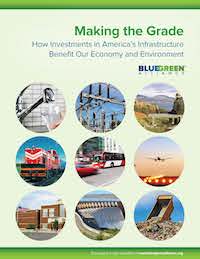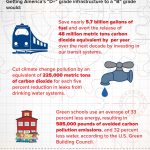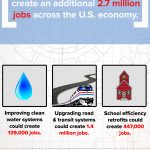Making the Grade: How Investments in America’s Infrastructure Benefit Our Economy and Environment
This innovative report shows that repairing America’s infrastructure could create 2.7 million jobs, increase the U.S. Gross Domestic Product (GDP) by $377 billion,and reduce carbon pollution and other greenhouse gas emissions.
Our innovative report shows that repairing America’s infrastructure could create 2.7 million jobs across the economy and increase the U.S. Gross Domestic Product (GDP) by $377 billion, while reducing carbon pollution and other greenhouse gas emissions and better protecting communities from the impacts of climate change.
Every four years, the American Society of Civil Engineers (ASCE) releases a report card depicting the condition and performance of America’s infrastructure across a number of sectors of the U.S. economy, the latest being the 2013 Report Card for America’s Infrastructure. Unfortunately, America consistently gets barely passing grades and our infrastructure systems are in dire need of modernization. In 2013, ASCE gave the nation’s infrastructure a grade of “D+,” which is a slight improvement over previous “D” grades, and estimated that to get to a grade of “B” would require an investment of $3.6 trillion over the next seven years. It also showed that the gap between planned infrastructure investment and the amount required to achieve a good state of repair is currently an estimated $1.6 trillion dollars.
This report delves into the economic impacts of closing that gap by accelerating infrastructure investment—using current financing approaches—to achieve a “B” grade over the next 10 years. Making these investments now will pay big dividends making our country more efficient and in reducing carbon pollution and other greenhouse gas emissions driving climate change. Such an endeavor would accrue significant sustainability benefits across the economy. For each of the sectors examined in the ASCE Report Card, accelerated infrastructure investment could help achieve the following environmental benefits, including but not limited to:
- Saving nearly 5.7 billion gallons of fuel and averting the carbon dioxide equivalent of 48 million metric tons per year over the next decade by supporting the current trajectory of transit ridership. Currently, transit ridership levels save the equivalent energy of the gasoline used by more than 7.2 million cars a year—nearly as many cars as are registered in Florida, the fourth largest state;
- Reducing climate change pollution by an equivalent of 225,000 metric tons of carbon dioxide for each 5 percent reduction in leaks from drinking water systems;
- Helping to reduce power plant emissions by 30 percent below 2005 levels over the next three decades by investing in more efficient power plants and the electrical grid; and
- Reducing greenhouse gas emissions by approximately 10 million tons of carbon dioxode—equivalent to the carbon pollution emissions of six million U.S. households—for each 5 percent reduction in the amount of solid waste Americans generate.
Stimulating the economy, creating jobs, fighting climate change, and improving our communities—now and for generations to come—are all good reasons to prioritize infrastructure investment.


